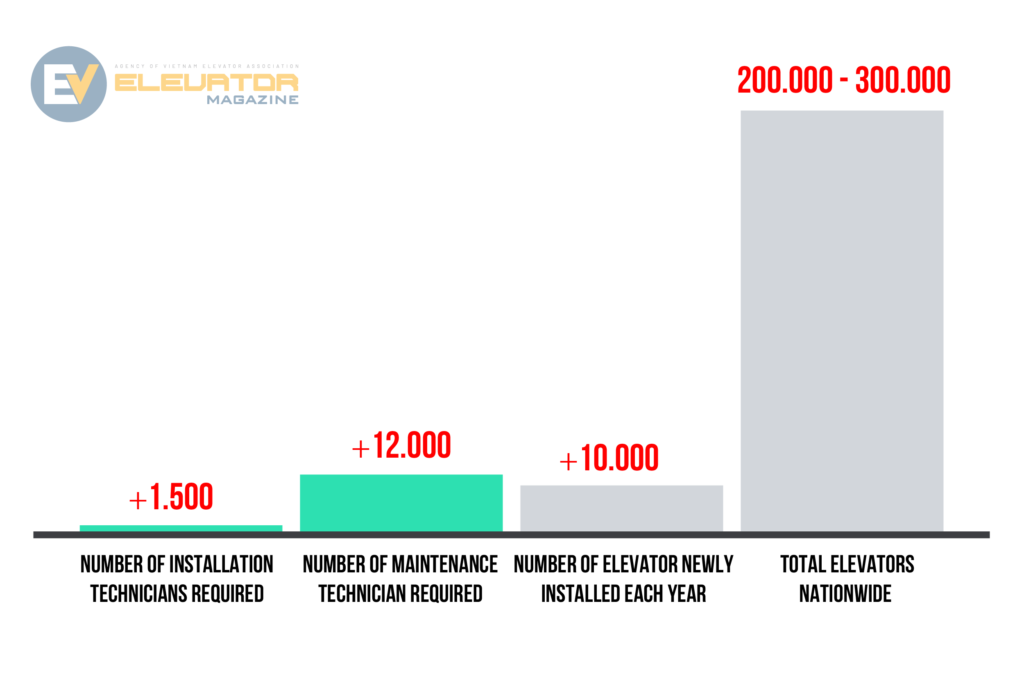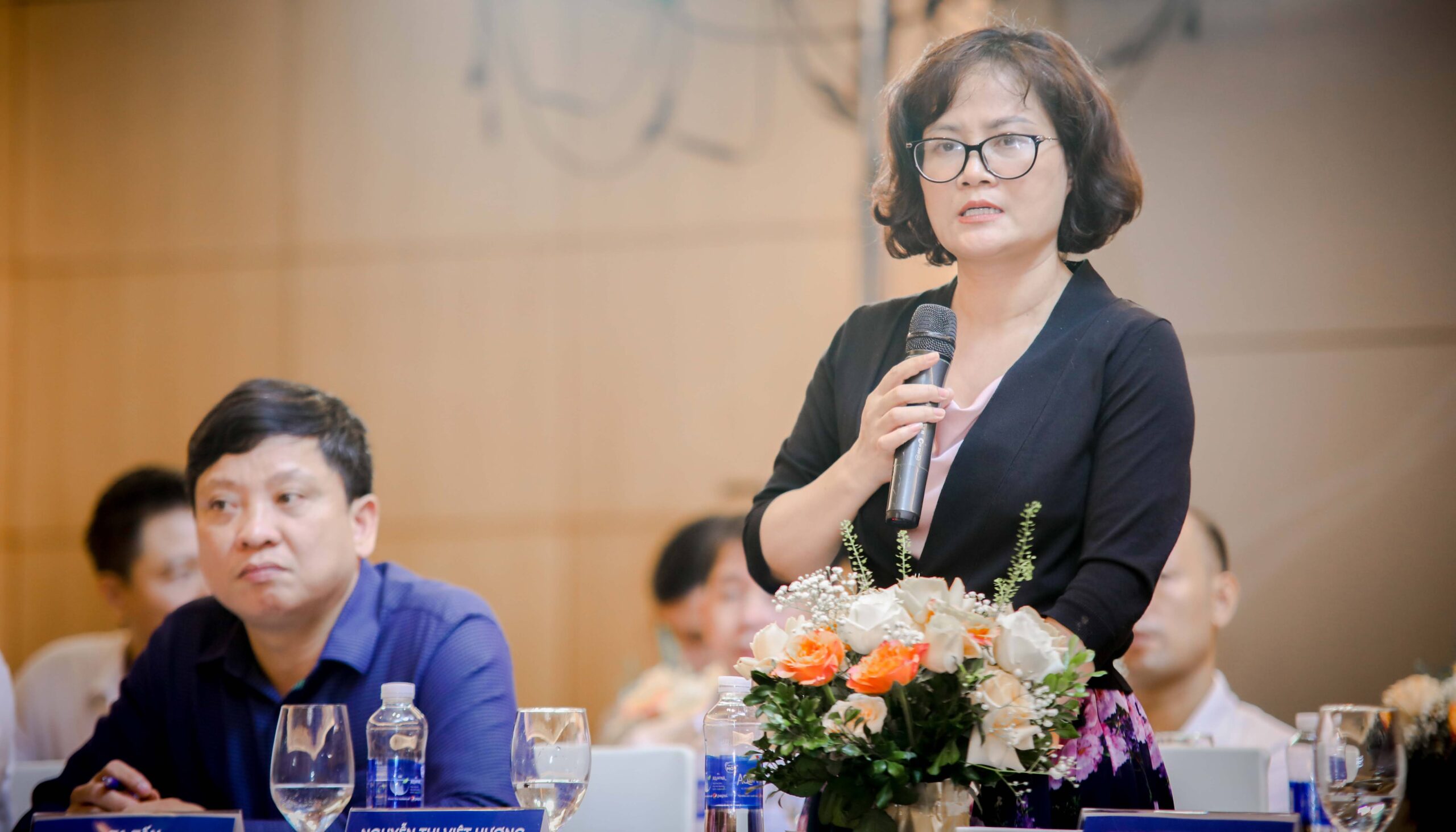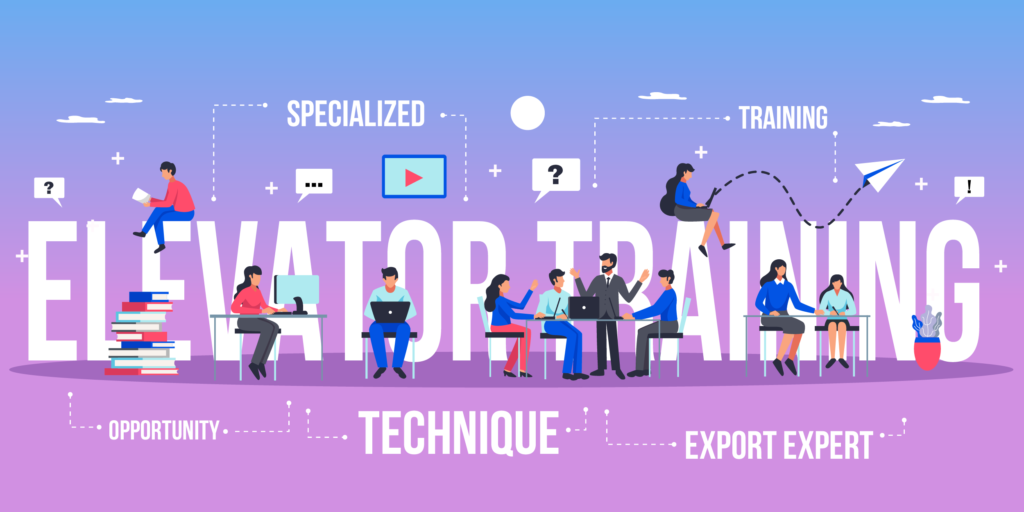EM – The urgency of the issue of standardizing human resource training in the elevator industry has been recognized by relevant agencies and the business community, but so far there has been no solution. We need to soon standardize human resources in the elevator industry, not only to meet the domestic market but also towards exporting high-tech labor.
There is no specialized training unit in elevator engineering
Currently, there are about 250,000 – 300,000 elevators installed and used across the country. Every year, about 10,000 new elevators are installed and this number will continue to increase in the coming time. Mechanically, the number of technical staff required to perform maintenance and repair will be about 12,000 people (1 person/25 elevators). The number of staff to install the elevator needs about 1,500 people (7 people / 1 elevator).

The numbers reflect the demand for labor in the elevator industry
This fact poses the problem of human resources to meet the professional elevator installation, maintenance and operation. It requires a team of highly qualified, professional and capable technicians to meet the advanced skills when the 4th industrial revolution is having a strong impact on the industry.
Such is the demand, but currently, no organization has come forward to standardize framework training programs. This is unprecedented and difficult from many sides such as limitations of policy mechanisms, division in the industry and lack of “leader”. We also don’t have a set of National Occupational Skills Standards for the elevator industry. This idea has also recently been officially launched for discussion and public comment.
At the Conference “Improving the quality of human resources in Vietnam elevator industry” which took place on July 13, Assoc. Dr. Nguyen Thi Viet Huong, Deputy Director General of the General Department of Vocational Education, Ministry of Labour, Invalids and Social Affairs, we have frankly set forth the conditions on human resources to ensure the quality of work of enterprises, of the elevator industry and that is the solution that forces businesses to check whether they have enough capacity to participate in the labor market. Therefore, the idea of proposing to develop the Vocational Skills Standards of the Vietnam Elevator Association, in order to improve professional skills and ensure regulations on labor and safety, is very urgent and useful. This also shows VNEA’s very high social responsibility to the community.

View from developed countries
Referring from Korea, in recent years elevator engineering is a field that has been interested and trained. Korea has its own training school for the elevator industry: Korea Elevator Academy – elevator engineering school. This is where the industry’s leading engineers are trained through the development of specialized training courses, applying the National Competency Standards (NCS). With a specific field of study, meeting the demand for high-quality human resources, it is increasingly attracting the attention of domestic and international students.
In the United States in 1967, the National Elevator Industry Education Program (NEIEP) was established. Extensive educational programs are designed to train apprentices, as well as provide continuing education opportunities for qualified technicians to meet industry-wide needs, while providing a standard curriculum for the national elevator operator exam. The program is considered to have contributed positively to the development of the industry in this country over the years.
In the UK, in the national vocational training program, recently renamed the “Certificate of Qualifications Framework”, the LEIA is recognized as an approved assessment unit, awarding certificates at three levels: qualifications in installation and commissioning of elevators and escalators, technical maintenance and servicing of elevators and escalators. These ensure effective on-site, step-by-step personal training.
In Poland, the Polish Association of Lift Manufacturers (PALM) has proposed a new curriculum for elevator engineering. It takes approximately 210 hours to train future elevator technicians by combining school training and practical practice, in line with the needs of companies and the latest technological developments in the elevator market.
Currently, many developed countries in the world face a shortage of human resources due to population aging, leading to a great need to import foreign workers to meet production needs. And that is an opportunity to export technical manpower in the elevator industry after meeting the output standards. It also contributes to the strategic planning of human resource development of the country in new periods, opening the prospect of attracting foreign currency and developing the country.
Need an organization to develop and standardize the elevator technical training program
Vietnam Elevator Association is actively coordinating with the Hanoi High-Tech Vocational College (HHT), urgently preparing all necessary conditions according to the regulations on opening the elevator training industry and submitting it to the General Department of Education soon for permission to open the elevator engineering industry code. If the industry code is approved soon, right this year, HHT will enroll the first regular elevator technician training course in the country.
As a unit under the Vietnam Elevator Association, Vietnam Institute of Lift Engineering Application (VILEA) will be the unit that standardizes the elevator technical training program. This is an important premise that will solve the problems of lack of qualified human resources and, more broadly, towards the goal of bringing the elevator industry to sustainable development.

Professionalizing human resource training will solve the “bottleneck” of Vietnam elevator industry
VILEA will carry out the training of elevator installation, maintenance and repair staff with meticulously compiled documents from a team of leading experts and experienced engineers. Students participating in the course will receive solid training in theory, master practical skills and have to pass an exam to get a certificate. Certificate levels will clearly classify each student’s level.
At the same time, VILEA cooperates with domestic and foreign training organizations, providing students with equipment and elevator models currently on the market to update according to the effective training method which is Learning by doing.
VILEA also cooperates closely with reputable domestic and foreign elevator manufacturing companies to create conditions for students to practice, learn and gain experience on many types of elevator and different types of projects.
Support for technology transfer is also one of the important orientations in the coming time, promoting the fledgling elevator industry in the country to take a shortcut in terms of technology, orienting training to upgrade vocational skills. These are the must-go roads in the pivotal phase of the Industrial Revolution 3.0 and 4.0.
This is the first time in the vocational education system in Vietnam, elevator engineering has the opportunity to officially be included in the training program. The development and standardization of training programs on elevator engineering is practical to connect labor sources, creating conditions for graduates to find jobs and businesses to find skilled candidates meet job requirements easily./.



